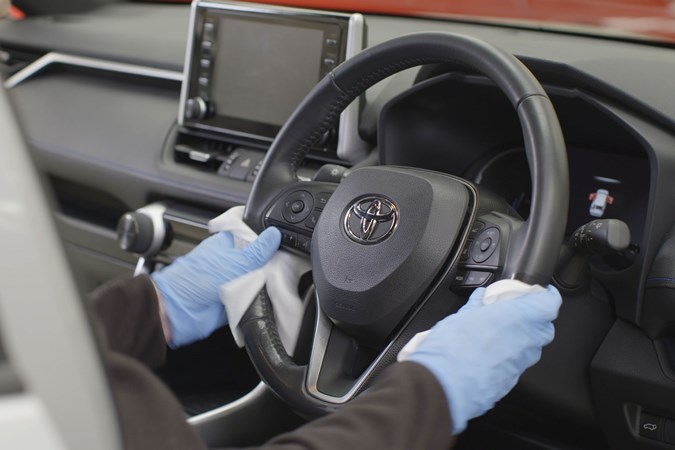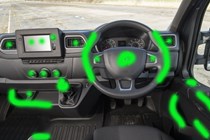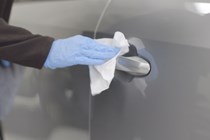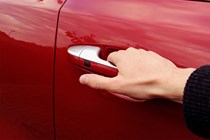With a second COVID-19 coronavirus lockdown looming, the reliance on van drivers to keep working will continue to be greater than ever. However, it’s essential that in order to keep this going, we should do everything possible not to contract or spread the virus.
With that in mind, here’s a recap of our quick 10-point guide for all drivers, not just van drivers, which has been produced in line with the guidance provided by UK Government.
1) Start the day
To minimise the risk of infection in the cab and loadbay at the start of every working day, clean any areas likely to be touched by the driver or passengers. These should include the steering wheel, gear selector, handbrake, ventilation controls, radio/infotainment, seat controls, seat belts, grab handles and mirror adjusters. Be careful not to make the steering wheel and gearlever slippery in the process. See images in the gallery above for suggested areas to be cleaned.
2) Clean outside
On the outside, clean all handles and doors especially in those areas likely to be touched (when slamming shut, etc). Also, pay close attention to the fuel flap and filler. When was it last refuelled? Can’t remember or don’t know? Give it a clean.
3) Be prepared
Keep cleaning products in the cab. If there’s a driver swap, remember to clean all those areas likely to be touched by the driver.
4) Clean the cab
In the cab, to reduce the spread of germs when you cough or sneeze, cover your mouth and nose with a tissue, or your sleeve (not your hands) if you don’t have a tissue. Remember to throw the tissue away immediately. Then wash your hands or use a hand sanitiser.
5) Check who you’re visiting
If you know who you’re visiting, contact them first to see if they are showing any symptoms of COVID-19. If they are, or are already self-isolating, and the visit is essential, arrange a delivery spot that keeps you away from that person.
6) Don’t shake hands
Don’t shake hands on delivery and whenever you get in or leave the vehicle, use sanitiser gel to clean your hands. Avoid touching your face at all times. Also, when you get the opportunity, ensure that your hands are washed regularly following World Health Organization (WHO) guidelines – 20 seconds with soap and hot water.
7) Is your drive essential?
The government’s guidelines are to avoid all non-essential travel.
8) Plan your route to avoid potential traffic hold-ups.
Have a look at where you’re going, and if you’re doing multiple visits or have several destinations, try to look at the most efficient route possible in order to avoid spending time spent in standing traffic. Consider time of travel – if you don’t have a set time, can you travel later in the evening or earlier in the morning? This way you’ll avoid potential contact with others, especially if there are traffic problems or you need to stop along the way.
9) Clean again
When you’ve finished for the day, clean the cab and loadbay again, taking care to wipe all the areas that have been touched in the day. Also remember to remove any rubbish from the cab that could be harbouring the virus.
10) Check outside and in
Once you’re out, wipe all the door handles and door shuts, sanitise your hands again, and when you’re indoors, thoroughly wash your hands for 20 seconds following the World Health Organization guidelines.
These are the current guidelines and best practice to follow in order to stay safe in your work – and please bear in mind that at the current time and based on our understanding of what is known of COVID-19, it is likely that older people and those with chronic medical conditions may be vulnerable to severe disease.
Follow these guidelines, and help slow the spread of this virus.
Full list of touch points to consider to thoroughly clean your van (or car)
Further to the above, Toyota has come up with a list of 40 touch points around a vehicle that should be cleaned if you want to reduce germs and potential for infection.

The original list was based on a car, and provided by the Toyota press office’s in-house valeter, so we’ve adapted it slightly to suit the majority of vans. If nothing else, this list should give you plenty of ideas about where on your van – or pickup – that will need attention.
1) Exterior door handles
2) Frame of door and roof
3) Interior door release
4) Window switches
5) Interior door handles
6) Door pocket
7) Seatbelts
8) Seatbelt clips
9) Seat adjust buttons
10) Steering wheel
11) Horn
12) Control stalks
13) Air vents
14) Dashboard
15) Power button
16) Gear shift
17) Multimedia screen
18) Central air vents
19) Heating controls
20) Glovebox
21) Log book
22) Central storage compartment
23) Cupholders
24) Rear-view mirror
25) Interior lights
26) Grab handle
27) Key
28) Head rests
29) Seat pockets
30) Rear central tab
31) Fuel cap (and AdBlue filler)
32) Wheel valves
33) Load area door handles
34) Load area grab handles
35) Load floor
36) Any fitted racking or other load area accessories – including load-through bulkheads
37) Bonnet
38) Washer cap
39) Dipstick
40) Oil cap
Toyota also recommends wearing gloves when cleaning, and even when travelling in taxis and rental cars.
Also read:
>> Nine tips to keep your van in working order
>> Van dealers and service centres still open during COVID-19 pandemic
>> What to do if you need a payment holiday on your van or pickup finance or lease
>> Do I still need to get an MOT for my van during the COVID-19 pandemic?
>> Van and pickup warranty advice during the coronavirus pandemic



















